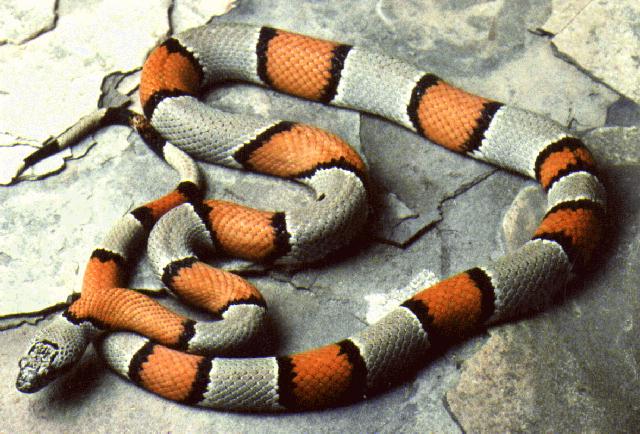
Gray-bandedkingsnake(Lampropeltis alterna)
Phylum —chordata
Class — reptilia
Order — squamata
Family — colubridae
Genus –lampropeltis
Appearance
A moderately sized snake, the gray-banded kingsnake can grow up to 4 ft (120 cm) in total length (including tail), with the average total length being 3 ft (91 cm). It has a relatively wide head (when compared to other kingsnake species), and has large eyes with round pupils.
Lampropeltisalternacoloration and patterning vary greatly, but there are two main color morphs, which were once considered separate subspecies: the "blairi" which has wide red/orange banding, and the "alterna" which has thinner orange/red banding. Both are generally on a gray background with white and/or black accenting. There are many variations on this basic morphology found in the wild and captive bred, with some specimens even lacking orange or red banding entirely.
Habitat
The species is endemic to the southwestern United States and adjacent Mexico.
Behavior
It is a common species, but nocturnal and quite secretive. Gray-banded kingsnakegenerally has a calm disposition and is not prone to defensive reactions, like biting. They are nonvenomous and have immunity to rattlesnake venom.
Diet
The gray-banded kingsnake feeds primarily on lizards. It will occasionally feed on small rodents, frogs, and the eggs of ground nesting birds, lizards, and other snakes.
Reproduction
Gray-banded kingsnakeis oviparous, laying clutches of 3–13 eggs in early summer, which hatch in approximately 9 weeks. Each hatchling is around 10 in (25 cm) in total length.
Incaptivity
Lifespan is about 15-20 years.
As with most snakes, the enclosure should be as long on one end as the snake is long. Since gray-banded kingsnakes are typically 2-3 feet long (61-91 centimeters), a 2-3 feet long enclosure, such as a 40 gallon breeder tank, will be adequate for most snakes. However, longer snakes will need larger enclosures, so that they can fully stretch out their body. A front-opening vivarium is preferable to a top-opening one, but those can be used as well. As with all snakes, make sure the cage is completely escape-proof. Additionally, kingsnakes are snake-eaters, so they should always be housed solitarily.
Since they do not require high humidity, the substrate does not have to hold moisture. Aspen wood shavings are a popular choice, but other options include kiln-dried pine, cypress mulch or orchid bark (kept dry), and a mix of sand and soil, which can be used in bioactive setups. Loose substrate should be used to allow them to burrow, but paper towels are a great substrate to use during quarantine.
Use loose substrate and provide the snake with two hides, one on each side of the terrarium, and other decor such as plants, branches, tubes, vines, etc. This will not only add security to the terrarium, but also encourage climbing. Creating a bioactive setup may also add enrichment.
An under-tank heater (UTH) such as a heat mat, heat tape, or heat cable is a good source of warmth for kingsnakes. Make sure the UTH covers at least 1/3, but preferably 1/2, of the floor space. The surface temperatures above the UTH should be in the high 80s (30-31°C). The ambient temperatures should be in the mid to high 70s (24-25°C) throughout the enclosure. They tolerate a fairly large range of humidity levels, but it should not be below 25% or above 45%. However, it can be raised up to 55% during shedding. A humid hide box may also be given during this time. If the humidity is too high or too low for an extended amount of time, shedding issues or even an upper respiratory infection can occur. Ambient temperatures should be measured with a digital probe thermometer, and surface temperatures should be measured with an infrared temperature gun. Always connect all heat sources to a thermostat or dimmer to prevent burns or fires, and so you can control the temperatures. Humidity should be measured with a digital probe hygrometer. Don’t rely on stick-on analog thermometers and hygrometers, as they are notoriously inaccurate. Also avoid heat rocks; they are known to overheat very easily and burn animals.
Since gray-banded kingsnakes are nocturnal, they do not require UV lighting; however, a linear 5-6% UVB light is beneficial and can be utilized, but again, it is not essential. As with most herps, they must be provided with some source of lighting during the day to allow a day-to-night-cycle. Natural lighting can provide this, or LED lighting can be used in the enclosure, especially if it includes live plants. Always turn off all lights at night, including black, purple, or red ones. A ceramic heat emitter (CHE) can be used instead.
Gray-banded kingsnakes should always have a bowl of clean, fresh water available to them. No food dish is needed, but a Tupperware lid can be used during feeding to help avoid substrate being consumed.
Spot cleaning of the terrarium should be done whenever feces are spotted. The water bowl should be cleaned and refilled daily, and if it empties or becomes soiled with substrate or droppings. The substrate should be changed out according to the instructions by the brand. Deep clean the enclosure every few months. All water used for misting the tank and in the water bowl should be purified or treated, not distilled.
While each individual snake is different, kingsnakes tend to be non-aggressive, active, and curious snakes. Gray-bandeds are no exception. Because of this, they are easily handled. However, their lanky build and quick speeds means you have to stay alert when holding them to avoid an escapee. When removing your snake from their enclosure, always approach them from the side or back, and never from above or from the front. Limit handling to 30 minutes at a time, a few times a week. Furthermore, don’t handle a snake for 48 hours after they eat, and avoid handling during the shedding process to avoid stress.
 Russian
Russian
 English
English
























